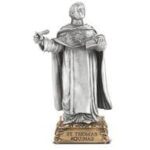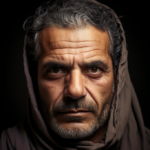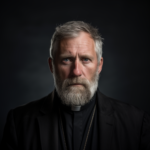St. Anthony the Abbot
St. Anthony the Abbot
Unveiling the Legacy of St. Anthony the Abbot: A Life Amidst Historical Turmoil
When They Lived:
St. Anthony the Abbot, also known as Anthony of Egypt, lived during the 3rd and 4th centuries. He was born in the year 251 AD and passed away on January 17, 356 AD.
Where They Lived:
St. Anthony spent the majority of his life in the deserts of Egypt, particularly in the region around the Red Sea. He is considered one of the pioneers of Christian monasticism and is often associated with the development of the desert hermit tradition.
Notable World Events During Their Life:
- Diocletian’s Persecution (303-313 AD): St. Anthony’s early life was marked by the severe persecution of Christians under the Roman Emperor Diocletian. This event not only shaped the religious landscape but also impacted the lives of countless individuals, including Anthony’s own spiritual journey.
- Edict of Milan (313 AD): The Edict of Milan, issued by Emperor Constantine the Great, marked a significant turning point in the history of Christianity. It granted religious tolerance to Christians and allowed them to practice their faith openly, which greatly influenced the spread of Christian beliefs.
- Council of Nicaea (325 AD): St. Anthony lived through the time of the First Council of Nicaea, where Christian bishops gathered to address theological controversies, resulting in the formulation of the Nicene Creed. This event laid the foundation for Christian orthodoxy and played a crucial role in defining core beliefs.
- Fall of the Western Roman Empire (476 AD): Though Anthony had passed away by this time, his legacy endured during the tumultuous period following the fall of the Western Roman Empire. The decline of centralized power in Europe led to the rise of various kingdoms and marked the transition from antiquity to the Middle Ages.
- Life of St. Augustine (354-430 AD): The influential theologian and philosopher St. Augustine of Hippo lived during the later years of St. Anthony’s life. Augustine’s teachings and writings would become integral to the development of Western Christian thought, contributing to the shaping of doctrine and theology.
Their Patronage:
St. Anthony the Abbot is renowned as the patron saint of various aspects of life, reflecting his profound influence on both the spiritual and practical realms:
- Patron Saint of Monasticism: St. Anthony’s solitary and ascetic lifestyle in the desert established a precedent for Christian monasticism, inspiring countless men and women to embrace lives of devotion, meditation, and self-discipline.
- Patron Saint of Animals and Grains: Legend has it that during his time in the desert, Anthony encountered various creatures and maintained a harmonious relationship with them. This led to his association with animals and, subsequently, his patronage over animals and the crops that sustain them.
- Protector against Infectious Diseases: In times of epidemic outbreaks, St. Anthony’s intercession has been sought for protection and healing from infectious diseases. This role has gained prominence, particularly in the context of historical plagues and modern health crises.
- Helper of Those in Despair: St. Anthony is often invoked by those facing spiritual desolation, personal struggles, or feelings of hopelessness. His own battles against temptation and his triumphs over despair make him a relatable figure for those navigating their own challenges.
A Radical Way of Life
St. Anthony the Abbot lived in the 3rd century. He was born to noble and wealthy parents in Egypt around the year 250. When he was about twenty years old, his parents died. Anthony began to practice an ascetic life at this age. Moved by the Gospel message, “Go, sell what you have, and give to [the] poor” (Mark 10:21b), he gave away all the money and possessions he and his sister had inherited.
When he was thirty-five years old, Anthony moved to the desert to live in solitude. As a hermit, Anthony practiced extreme asceticism. He ate little, prayed much, and fought the temptations of the devil to return to the city and its money. He was granted great wisdom by God, and so many people came to him for advice. Even emperors visited him and asked his opinion on various matters.
Fighting the Devil
St. Anthony was known to have faced spiritual combat. With what he envisioned as the forces of evil, his life was one long struggle against the devil. In the writings of St. Athanasius, the Bishop of Alexandria, the evil assaults on Anthony took the form of either horrible or seductive visions experienced by the saint. At times, the devil appeared to him disguised as a monk, bringing bread during his fasts. Other instances included the devil in the guise of women, wild beasts, or soldiers beating the saint and leaving him half-dead. In all these visions conjured up by Satan, Anthony repelled them with his fervent prayer and penitential acts.
A Community of Hermits
Before Anthony’s time, many men and women went out into the solitude of the desert to pray and do penance. These hermits lived alone and were far apart from other people. When he was 54, Anthony responded to many requests and founded a community of hermits. They spent most of their time alone. They met each day to worship and eat together.
Because of his spiritual gifts, Anthony drew many people to himself for spiritual guidance and healing. He left the solitude of the desert twice and walked to the big city of Alexandria. In his second visit to Alexandria, he preached against the heresy of Arianism, an erroneous doctrine teaching that Christ is not of the same substance as God the Father. He also comforted the victims of the persecutions of Maximinus and taught people the truth about Christ. He went back to the desert, and someone began to gather Anthony’s words of wisdom.
When he was 60 years old, Anthony desired to become a martyr during the renewed Roman persecution in the year 311. He fearlessly exposed himself to danger, at the same time giving moral and material support to those in prison. Anthony died in solitude at the age of 105 at Mount Colzim. His feast day is January 17.
5 Interesting Facts About St. Anthony the Abbot
- St. Anthony the Abbot is also called the Desert Father and St. Anthony of Egypt.
- Most of the known facts about St. Anthony the Abbot are derived from the biography of St. Athanasius, the “Father of Orthodoxy.”
- St. Athanasius wrote that St. Anthony the Abbot was unable to read or write because he could not bear the rough behavior of the boys in the school.
- St. Anthony the Abbot is generally considered to be the founder and father of organized Christian monasticism, although he himself preferred to live the life of a true hermit, apart from any community, in the deserts of Egypt.
- St. Anthony the Abbot is associated in art with a T-shaped cross, a pig, and a book. The pig and the cross are symbols of his valiant warfare with the devil; the cross is his constant means of power over evil spirits, and the pig is a symbol of the devil himself.
Prayer to St. Anthony the Abbot
O God, who brought the Abbot Saint Anthony to serve you through a wondrous way of life in the desert, grant, through his intercession, that, denying ourselves, we may always love you above all things. Through our Lord Jesus Christ, your Son, who lives and reigns with you in the unity of the Holy Spirit,God, for ever and ever Amen.



